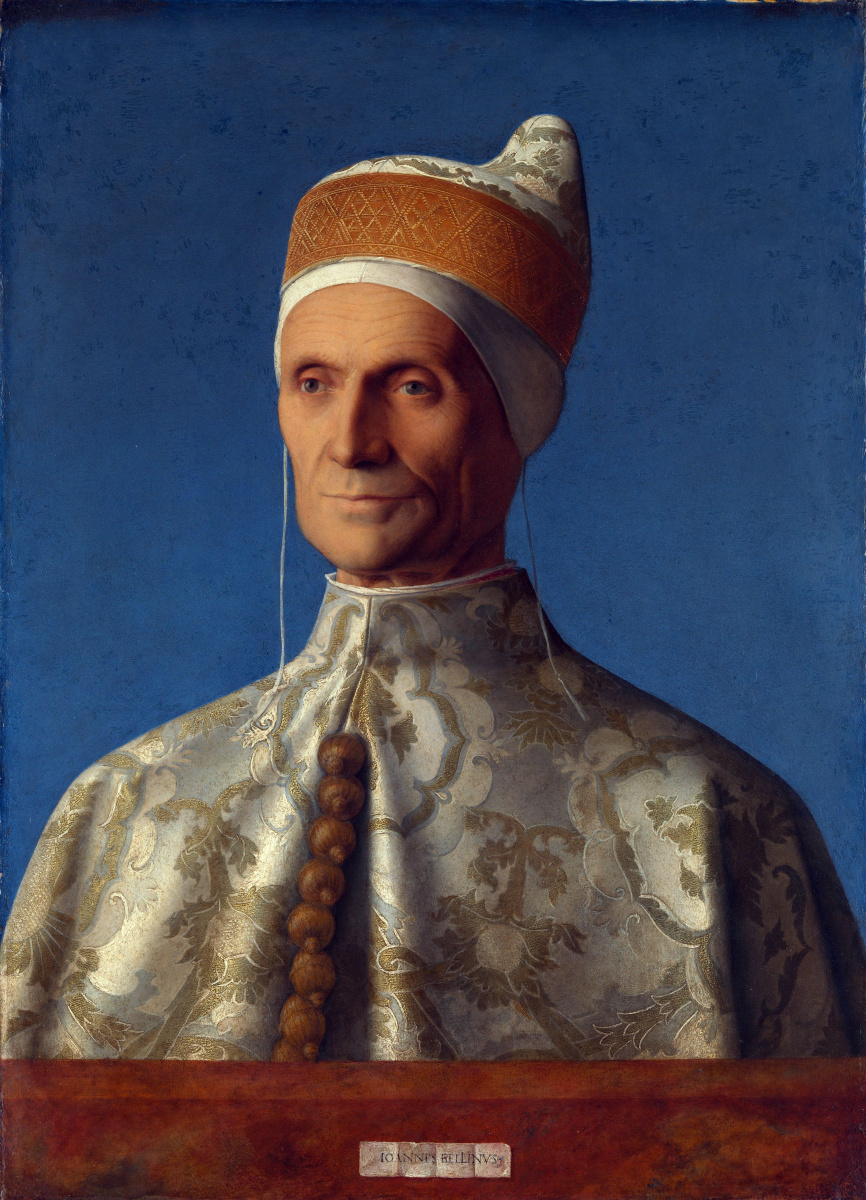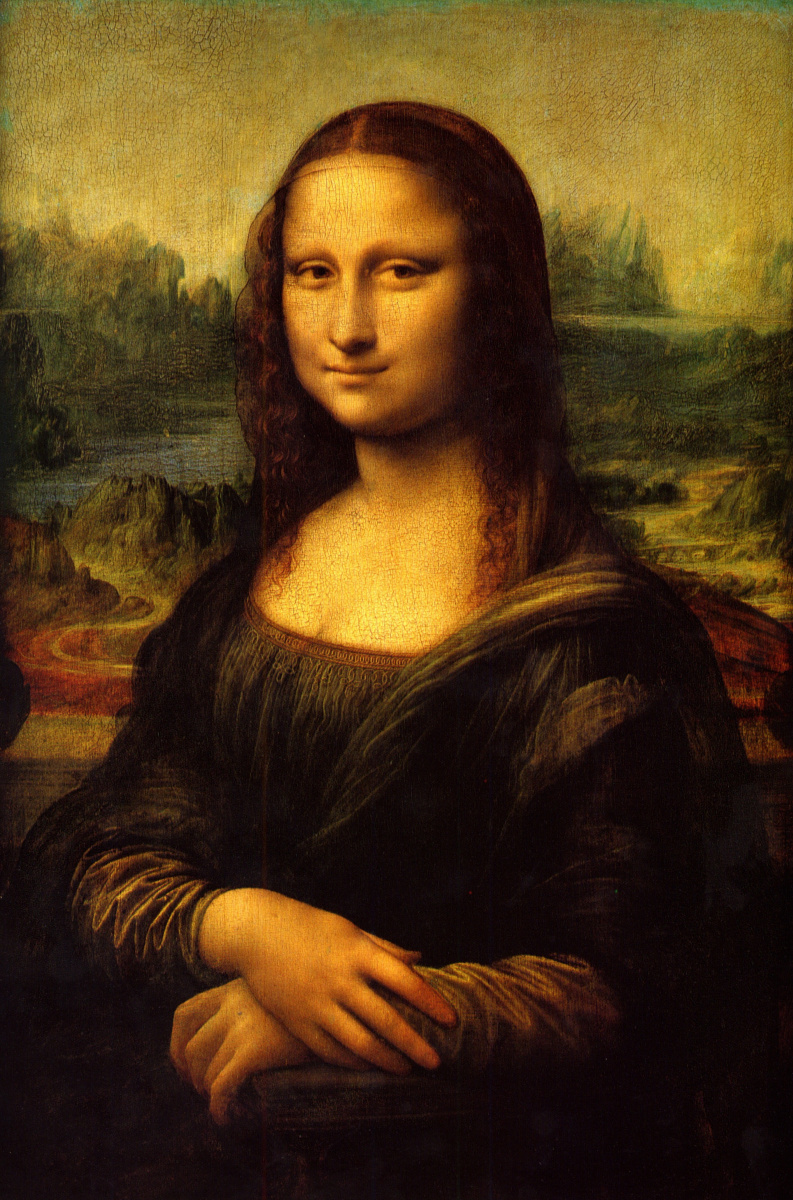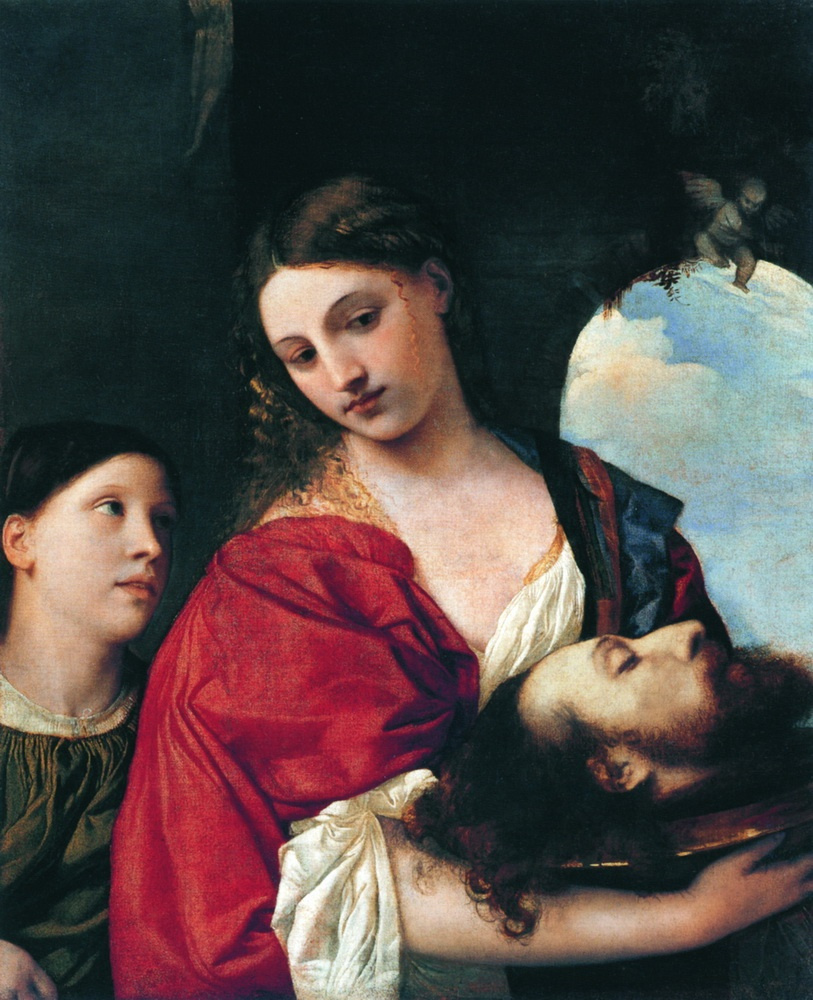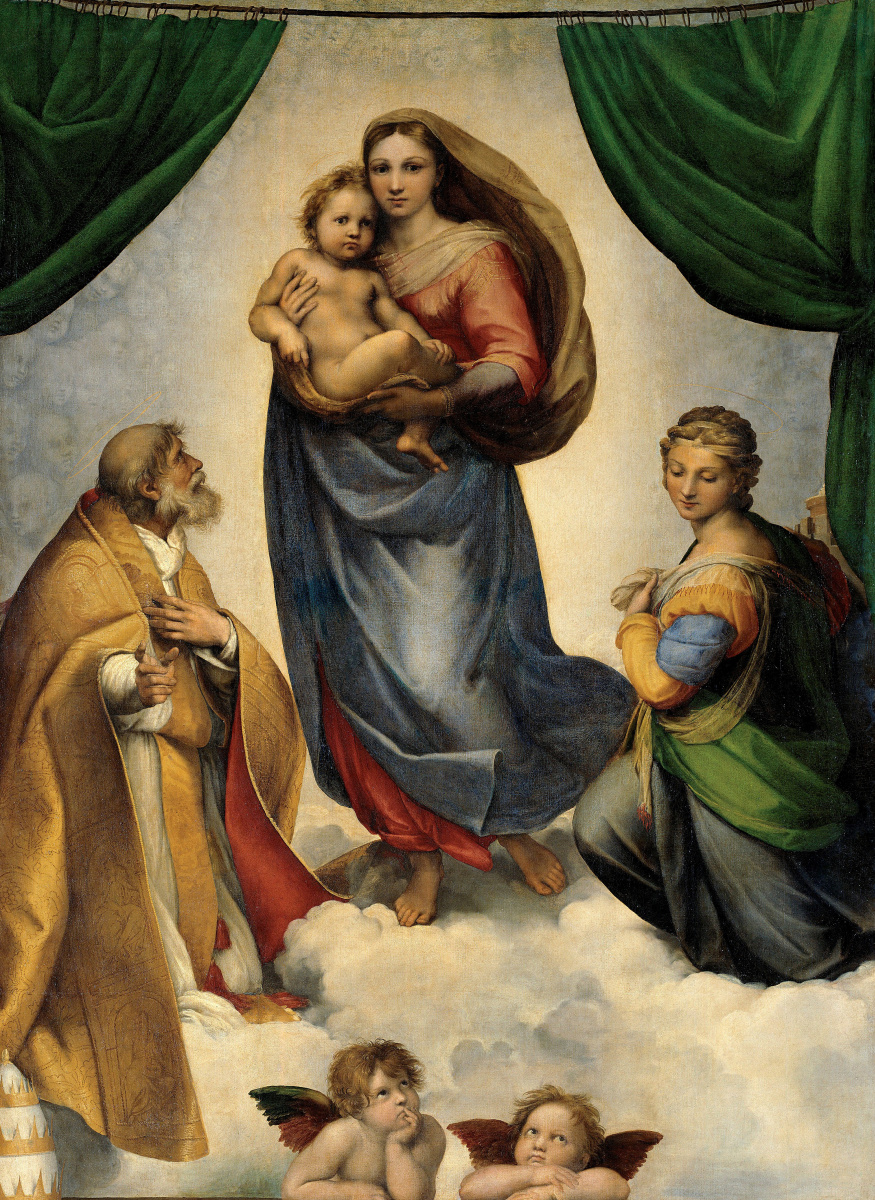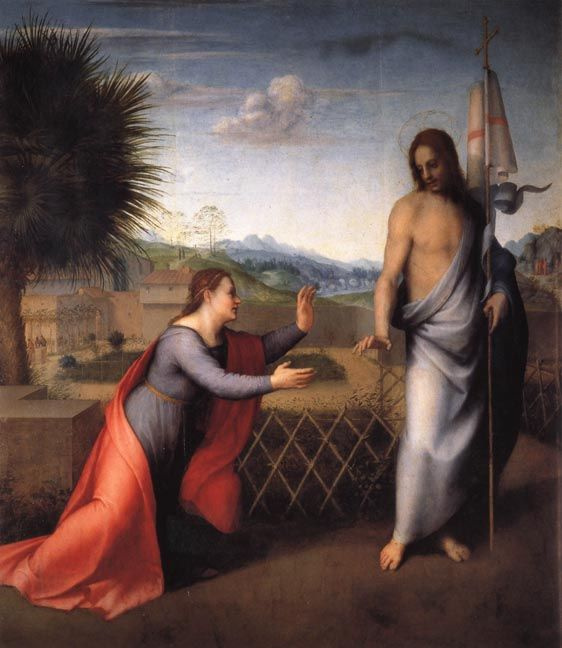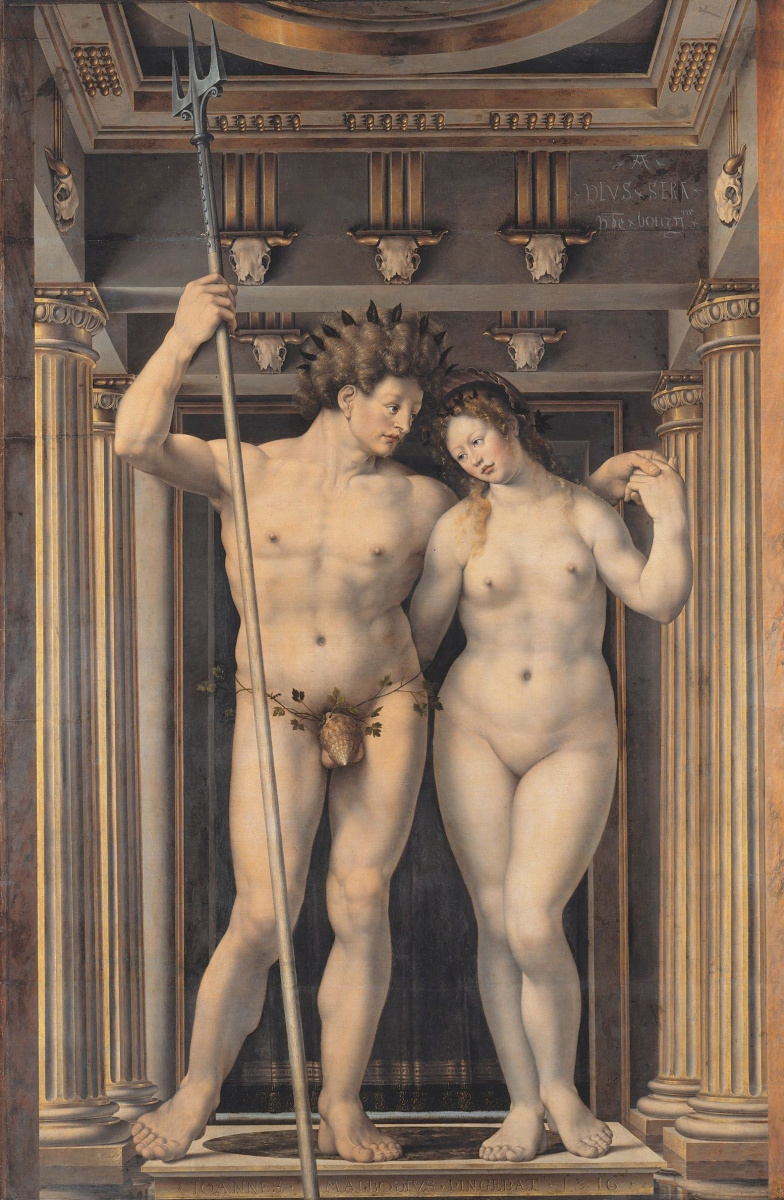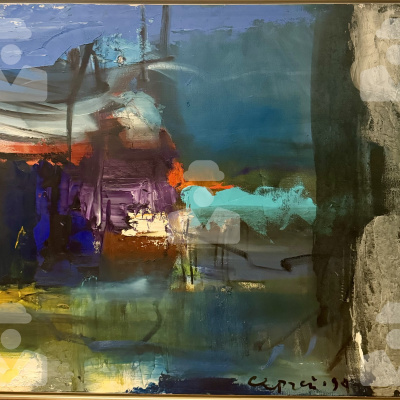Did you know that the most familiar artworks of the Renaissance
The Garden of Earthly Delights by Bosch, Mona Lisa or La Gioconda by Leonardo da Vinci and The Sistine Madonna by Raphael were not only painted in the same century, but in the same fifteen years of the XIV century, so we can say they were all created at the same time?

When the Garden of Earthly Delights was painted?
The date of the famous triptych is still under discussion and maybe the problem of its dating could be as important as the treatment of its symbolism and hidden senses. When did Bosch produce his Garden of Earthly Delights? Did he create it when he was old, skillful and experienced, or when he was a youngish man ready for risky experiments? The range of the supposed dates (from 1494 to 1515) is as wide as the range of the arguments proving each dating.
The astrological theory, which claims that the triptych was produced in 1504, is rather interesting; that very year the Sun and the Moon entered the constellation Cancer and the coral fountains depicted in the central panel of the Garden of Earthly Delights were related to this zodiacal sign. Some scholars move the date of the Garden of Earthly Delight to the later period, about 1505 — 1515, supporting their point of view with the statement that during that period Bosch was a consummate master of his craft and climbed the peak of his skill and his artwork surpassed in artistic merit his artworks performed at the turn of the XVI century. Meanwhile, the other art experts in Bosch’s oeuvre think that the Garden of Earthly Delights is very close stylistically to the triptych the Adoration of Magi dated 1494.
It is well-known that the Garden of Earthly Delights was first documented in 1517 by Antonio de Beatis, a canon from Molfetta, who accompanied Luigi d’Aragona (called the Cardinal of Aragón) in his trip to the Netherlands and described the work as part of the decoration in the town palace of the Counts of the House of Nassau in Brussels. The Catalogue of the exhibition that marked the 5th centenary of the death of Hieronymus Bosch at the Museo del Prado assumed that the Garden was commissioned by Engelbrecht II of Nassau, who died in 1504, and the date of finishing of the artwork is assumed to be the early 1490s. It has recently been argued that it must have been painted in or after 1494 as the image of God the Father creating the world on the reverse of the triptych and has been inspired by a print by Michael Wolgemut of the same subject.
The date of the famous triptych is still under discussion and maybe the problem of its dating could be as important as the treatment of its symbolism and hidden senses. When did Bosch produce his Garden of Earthly Delights? Did he create it when he was old, skillful and experienced, or when he was a youngish man ready for risky experiments? The range of the supposed dates (from 1494 to 1515) is as wide as the range of the arguments proving each dating.
The astrological theory, which claims that the triptych was produced in 1504, is rather interesting; that very year the Sun and the Moon entered the constellation Cancer and the coral fountains depicted in the central panel of the Garden of Earthly Delights were related to this zodiacal sign. Some scholars move the date of the Garden of Earthly Delight to the later period, about 1505 — 1515, supporting their point of view with the statement that during that period Bosch was a consummate master of his craft and climbed the peak of his skill and his artwork surpassed in artistic merit his artworks performed at the turn of the XVI century. Meanwhile, the other art experts in Bosch’s oeuvre think that the Garden of Earthly Delights is very close stylistically to the triptych the Adoration of Magi dated 1494.
It is well-known that the Garden of Earthly Delights was first documented in 1517 by Antonio de Beatis, a canon from Molfetta, who accompanied Luigi d’Aragona (called the Cardinal of Aragón) in his trip to the Netherlands and described the work as part of the decoration in the town palace of the Counts of the House of Nassau in Brussels. The Catalogue of the exhibition that marked the 5th centenary of the death of Hieronymus Bosch at the Museo del Prado assumed that the Garden was commissioned by Engelbrecht II of Nassau, who died in 1504, and the date of finishing of the artwork is assumed to be the early 1490s. It has recently been argued that it must have been painted in or after 1494 as the image of God the Father creating the world on the reverse of the triptych and has been inspired by a print by Michael Wolgemut of the same subject.
The garden of earthly delights
1500-th
, 220×390 cm
Art historians believe that Bosch’s oeuvre is so unique and exclusive that it cannot be compared with any other artworks in the history of arts. A little is known about the life of Bosch. The above factors create some kind of illusion of the exclusiveness of Bosch in the historical context. Bosch seems to exist outside the hours; one finds it hard to believe that he, Albrecht Dürer and Titian lived and produced their masterpieces at one and the same time and Bosch and Leonardo da Vinci were age-mates. That was the reason why the idea to synchronize in time ten top artworks had started up; these artworks were created at the time when Hieronymus Bosch produced his Garden of Earthly Delights in his native town of 's-Hertogenbosch, which he had never left.
Portrait of Doge Leonardo Loredana
1502, 61.4×44.5 cm
When Giovanni Bellini, known as the most charming painter of XV century, produced the Portrait of Doge Leonardo Loredan, he was well on into his seventies. The age of the Doge was the same: the artist and the ruler of the powerful Venetian State belonged to the same generation and likely knew each other well. The artwork is the best portrait painting by Bellini, the features of Loredan’s face are depicted vivid and clear cut, well defined face bones, deep-set eyes, a straight projected nose, a firm chin are is subtly reinforced by Bellini’s use of light. The artist pays meticulous attention to the Doge’s ceremonial outfit, especially the gold-threaded damask and patternwork of his brocaded silk jacket painted against a mazarine background. We also know why the Doge dressed this ceremonial outfit; during the Candlemas he became engaged with the sea to get power over the St. Mark Republic for another year.
The similar artwork is impossible for Bosch’s oeuvre, he painted no portrait (probably, it was his principal stand), he was not interested in historical specificities, a personality and Italian art innovations were indifferent for him. In a word, Bosch was a real representative of the Middle Ages. Though, the Garden of Earthly Delights and the Portrait of Doge Leonardo Loredan might have been produced during the same days.
The similar artwork is impossible for Bosch’s oeuvre, he painted no portrait (probably, it was his principal stand), he was not interested in historical specificities, a personality and Italian art innovations were indifferent for him. In a word, Bosch was a real representative of the Middle Ages. Though, the Garden of Earthly Delights and the Portrait of Doge Leonardo Loredan might have been produced during the same days.
The Creation Of Adam
1511, 570×280 cm
Michelangelo worked at the frescoes of the Sistine Chapel in the first decade of the XVI century. His most famous mural on the ceiling of the Chapel is the Creation of Adam; even those who have never been interested in art have seen the piece with the hands, the detail contacting fingers of God and those of Adam is the focal point of the artwork composition. What did Michelangelo intend to say? He depicts God flying through the endless sky after he has just created the first man Adam in his image and likeness. The hands of Adam and God are almost touching, though their fingers do not contact, the artist left a small space between them. God and a man in the Michelangelo’s artwork are tragically separated for ever, according to the artist’s philosophy heavenly and human is impossible to be connected.

It is interesting, what Bosch thought about this problem. Believe it or not, we could find an answer in the Garden of Earthly Delights. In his triptych Bosch picturized the other episode of the history told by Michelangelo in his fresco. On the left panel of the Garden Bosch depicted the moment of Eve’s creation: God had created a woman of the rib of Adam and was blessing them to go forth and multiply. At that moment Adam’s feet touched the bottom of God’s robe (or maybe it was his foot) holding Eve’s hand. We cannot say that Bosch is pessimistic; at least his God is much closer to a man than the God of Michelangelo.
Mona Lisa (La Gioconda)
1500-th
, 77×53 cm
The exact date of the La Gioconda has not been decided yet. The most probable period is assumed to be the period of 1503 — 1506. Some experts attribute this time to Bosch’s triptych creation: in 1504 the Sun and the Moon entered the constellation Cancer and the coral fountains painted in the central panel of the Garden of Earthly Delights were attributed to this zodiacal symbol.
The history of the Mona Lisa and masterpieces by Bosch appeared to be alike: the La Gioconda passed into the hands of the French monarch; the latter were acquired by the Spanish King. The La Gioconda was hanged on the wall of the bath house of King Francis I of France; Bosch’s artworks decorated the walls of the dining room and bed room in the palace of Philip II of Spain. The Spanish King was said to be watching the Bosch’s the Seven Deadly Things and the Four Last Things while preparing for his confession.
It is hard to believe but the bath house of Francis I appeared to be a very promising launching platform for the worldwide fame of the Mona Lisa. According to Grigory Kozlov’s book the "Stolen Treasure: The Hunt for the World’s Lost Masterpieces" the King housed the artwork in his bath house in the Palace of Fontainebleau because he knew well the value of the Mona Lisa. The bath house of the King was a very important place in France. Francis I relaxed there and enjoyed himself with his lovers and at the same time he fixed the burning problems of the State and received ambassadors.
Very soon Leonardo’s painting yielded wide popularity and some notorious halo; some artists used it for their remakes painting Mona Lisa nude, making blood of the righteous French people run cold; they thought Mona Lisa was a witch.
The Garden of Earthly Delights might have been under a cloud of suspicion of the Spanish Catholic Church. Though, it avoided the public denouncing and act of faith. The Spanish kings felt affection to Bosch’s oeuvre and the first historian of the El Escorial monk José de Sigüenza had nothing to do but state that the Garden of Earthly Delights had a deep exhortatory sense.
The history of the Mona Lisa and masterpieces by Bosch appeared to be alike: the La Gioconda passed into the hands of the French monarch; the latter were acquired by the Spanish King. The La Gioconda was hanged on the wall of the bath house of King Francis I of France; Bosch’s artworks decorated the walls of the dining room and bed room in the palace of Philip II of Spain. The Spanish King was said to be watching the Bosch’s the Seven Deadly Things and the Four Last Things while preparing for his confession.
It is hard to believe but the bath house of Francis I appeared to be a very promising launching platform for the worldwide fame of the Mona Lisa. According to Grigory Kozlov’s book the "Stolen Treasure: The Hunt for the World’s Lost Masterpieces" the King housed the artwork in his bath house in the Palace of Fontainebleau because he knew well the value of the Mona Lisa. The bath house of the King was a very important place in France. Francis I relaxed there and enjoyed himself with his lovers and at the same time he fixed the burning problems of the State and received ambassadors.
Very soon Leonardo’s painting yielded wide popularity and some notorious halo; some artists used it for their remakes painting Mona Lisa nude, making blood of the righteous French people run cold; they thought Mona Lisa was a witch.
The Garden of Earthly Delights might have been under a cloud of suspicion of the Spanish Catholic Church. Though, it avoided the public denouncing and act of faith. The Spanish kings felt affection to Bosch’s oeuvre and the first historian of the El Escorial monk José de Sigüenza had nothing to do but state that the Garden of Earthly Delights had a deep exhortatory sense.
Dead Bluebird
1512, 28×20 cm
Albrecht Dürer at his mature age got into the watercolor technique and reached the outstanding progress in it, (frankly speaking, his skill appeared to be unbeatable) at the time, when Bosch was working on his Garden of Earthly Delights. In 1512 Durer produced his watercolor the Dead Bluebird. By the way, we could find a lot of birds among the opulent fauna depicted in the Garden of Earthly Delights.
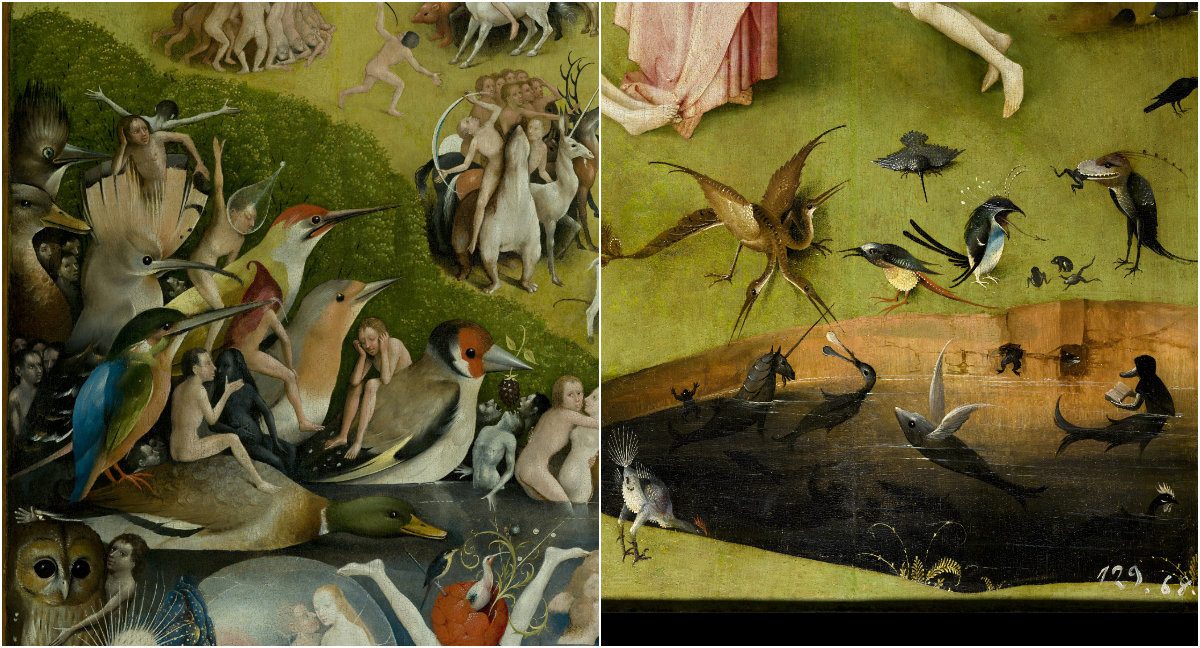
Bosch painted his birds with the clear elegance. The characters of the novel Ada by Vladimir Nabokov, obsessive about the painting by Bosch, discuss that the wings of the tortoise butterfly were depicted in the wrong way; the colors of them were confused with their back side. At the same time, the depiction of owls, robins, tits and jay birds were quite correct. However, the attention of the viewers to Bosch’s birds is focused on searching their hidden senses and allegorical meanings; Durer’s birds stagger our imagination with their astonishing realistic details but not with their symbolism
. Paws, beaks and feathers of Durer’s birds are painted almost scaring touchable realistic. When scrutinizing the birds by Bosch, you need to examine them and solve their mysteries, when seeing Durer’s birds you unwillingly want to take them.
The last of the great painters of the North Gothic is Matthias Grünewald (1470/75 — 1528), who was a contemporary of Bosch. His reputation was obscured until the late nineteenth century, and many of his paintings were attributed to Albrecht Dürer and his oeuvre was rediscovered only in the early XX century. The same happened with Bosch’s artworks. Surrealists announced Bosch their direct predecessor; Matthias Grünewald was privatized by the German expressionists recognizing him as their forgoer.
Around the time when Bosch was working on his Garden of Earthly Delights Matthias Grünewald was producing his polyptych the Isenheim Altarpiece, which later became known as a masterpiece.
At the first glance the Isenheim Altarpiece could seem very much alike the triptych the Garden of Earthly Delights, though the number of figures was much less. In reality the Altarpiece by Grünewald is much more complicated: it includes the central part consisting of a basket and two movable pictorial wings allowing three options of the altar. The picture demonstrates the only one view. So, the structure of the Isenheim Altarpiece is much more sophisticated than the Garden of Earthly Delights with its two options.
Around the time when Bosch was working on his Garden of Earthly Delights Matthias Grünewald was producing his polyptych the Isenheim Altarpiece, which later became known as a masterpiece.
At the first glance the Isenheim Altarpiece could seem very much alike the triptych the Garden of Earthly Delights, though the number of figures was much less. In reality the Altarpiece by Grünewald is much more complicated: it includes the central part consisting of a basket and two movable pictorial wings allowing three options of the altar. The picture demonstrates the only one view. So, the structure of the Isenheim Altarpiece is much more sophisticated than the Garden of Earthly Delights with its two options.
Salome with the head of John the Baptist
1515, 90×72 cm
Around 1515, great Italian painter Titian (Tiziano Vecelli or Tiziano Vecellio) produced his painting Salome with the 'Head of John the Baptist'. Bosch had finished his 'Garden of Earthly Delights' by that time and one could find the both artworks being much more in common that they could have seemed.
Firstly, their coloration: the prevailing pure and sounding colors contrast the dark and obscure details. Secondly, Titian’s image of Salome, a stepdaughter of the tetrarch Herod, combines, according to the scholars, closely related themes of eroticism and death, as "Garden of Earthly Delights" by Bosch". And thirdly (and perhaps the most interesting), both paintings contain very unusual self-portraits of their creators.
In the severed head on a platter, which Salome holds, it’s easy to recognize Titian`s noble profile. It was suggested that the artist painted Salome from his lover Violanta, the daughter of Titian`s friend, Palma the Elder, who was also a painter. This rare beauty of the model you can also see in the famous paintings "Flora' and "Heavenly Love and Earthly love". The legend has it that Palma was deeply outraged by his daughter`s affair with a much older Titian who did not intend to marry her. So, maybe the severed head of Titian in the hands of Violanta is the artist`s irony over the situation.
Firstly, their coloration: the prevailing pure and sounding colors contrast the dark and obscure details. Secondly, Titian’s image of Salome, a stepdaughter of the tetrarch Herod, combines, according to the scholars, closely related themes of eroticism and death, as "Garden of Earthly Delights" by Bosch". And thirdly (and perhaps the most interesting), both paintings contain very unusual self-portraits of their creators.
In the severed head on a platter, which Salome holds, it’s easy to recognize Titian`s noble profile. It was suggested that the artist painted Salome from his lover Violanta, the daughter of Titian`s friend, Palma the Elder, who was also a painter. This rare beauty of the model you can also see in the famous paintings "Flora' and "Heavenly Love and Earthly love". The legend has it that Palma was deeply outraged by his daughter`s affair with a much older Titian who did not intend to marry her. So, maybe the severed head of Titian in the hands of Violanta is the artist`s irony over the situation.

We could recognize a noble profile of Titian in the cut off head on the dish held by Judith. Judith is believed to be painted from the artist’s love mate Violante as a model; she was the daughter of his friend Palma the Elder, also a painter. She was a model for his famous artworks the Sacred and Profane Love and the Flora. The legend says that Palma was against the love affair of his daughter and much older Titian, who intended to marry her. We could assume that the cut off head of Titian in the hands of Violante could express some kind of irony of the situation.
Bosch has never produced his official self portraits. Though, art historians are long of hope to find his image among a lot of images created by him. A lot of experts almost have no doubt that the melancholic beast with the wooden torso on the right panel of the Garden of Earthly Delight depicts a self portrait of Bosch. Art historian Paola Volkova said: "I scrutinized the Garden of Earthly Delights by Bosch a lot of times and in detail. I assume that we could find the self portrait by Bosch on the panel entitled the Hell with a strange beast standing on whimsical legs resembling a rotten tree based on a dilapidated boat. The head of this zoomorphic creature is crowned with a hat with all the sinned souls from the Hell are dancing of its brims. No doubt, that its face is the face of Hieronymus Bosch."
The significant difference is that Titian’s head is on the dish and the dish is on Bosch’s head. We hope you would appreciate the wordplay.
Bosch has never produced his official self portraits. Though, art historians are long of hope to find his image among a lot of images created by him. A lot of experts almost have no doubt that the melancholic beast with the wooden torso on the right panel of the Garden of Earthly Delight depicts a self portrait of Bosch. Art historian Paola Volkova said: "I scrutinized the Garden of Earthly Delights by Bosch a lot of times and in detail. I assume that we could find the self portrait by Bosch on the panel entitled the Hell with a strange beast standing on whimsical legs resembling a rotten tree based on a dilapidated boat. The head of this zoomorphic creature is crowned with a hat with all the sinned souls from the Hell are dancing of its brims. No doubt, that its face is the face of Hieronymus Bosch."
The significant difference is that Titian’s head is on the dish and the dish is on Bosch’s head. We hope you would appreciate the wordplay.
German Renaissance
painter and printmaker in woodcut and engraving
Lucas Cranach the Elder was also a peer of Hieronymus Bosch. Though, we cannot find parallel features in their life histories. Bosch had never been a court nobility and likely never left his native town of 's-Hertogenbosch. Lucas Cranach was the court painter to the electors of Saxony in Wittenberg. Bosch had never produced made-to-order portraits. Cranach earned his money painting portraits of noble and rich men. Bosch was a religious burgher, whose paintings were appreciated in the catholic Spain. Cranach on the contrary embraced with enthusiasm the ideas of the Protestant Reformation, becoming a close friend of Martin Luther. We know nothing about Bosch’s offsprings. We are well aware of that Lucas Cranach was the father of the artistic dynasty.
At his last ten years Bosch following his unrestrained imagination produced his whimsical images and synthesized fantastic beasts and monsters. Cranach painted high-demanded realistic portraits of his Saxon patrons. Only the Gothic planeness and decorative figures without any Italian flirting with volume and light make to some extent closer Cranach and Bosch’s oeuvre, which is so different.
At his last ten years Bosch following his unrestrained imagination produced his whimsical images and synthesized fantastic beasts and monsters. Cranach painted high-demanded realistic portraits of his Saxon patrons. Only the Gothic planeness and decorative figures without any Italian flirting with volume and light make to some extent closer Cranach and Bosch’s oeuvre, which is so different.
The Sistine Madonna
1513, 269.5×201 cm
Nowadays it is a current belief that if Raphael Sanzio (Raphael Santi) had painted only his Sistine Madonna it would have been enough to recognize him as the greatest artist of all the times (the same is said about Bosch and his Garden of Earthly Delights). Raphael’s artwork yielded its fame not immediately. Almost for two centuries and a half the Sistine Madonna had been forgotten and had been housed as an altarpiece in the basilica church of the Benedictine Monastery of San Sisto in Piacenza. It had progressively become obscured with dust and smoke of candles and its colors lost its brightness and lucidity and thus public might have never seen the masterpiece. In 1745 the impoverished Benedictines decided to sell the Sistine Madonna to Augustus III, who was the King of Poland and Grand Duke of Lithuania from 1734 until 1763, as well as Elector of Saxony in the Holy Roman Empire
, who decorated with it his palace in Dresden.
The news about the masterpiece immediately spread all over Europe. Johann Joachim Winckelmann and Johann Wolfgang von Goethe wrote about it with adoration making the best promotion for it; the intellectual Russians starting their foreign trips in Dresden thought the Sistine Madonna must-to-see. Has the Sistine Madonna been ever removed from Dresden? Yes, it has been removed. During WWII at bombarding Dresden it survived hidden in a wagon in a tunnel in Saxon Switzerland. The Soviet soldiers found it and moved to the USSR. For ten years it had been housed at the Pushkin Museum before 1955, when it was removed back to Dresden. The artwork had been shown to the Russian public just before it was removed back. It was said that Faina Ranevskaya, a soviet actress, said that time that this lady (Madonna) had been adored by so many people that she yielded the right to choose who had to adore her.
The history of the Garden of Earthly Delights was much smoother, though, not so exciting. Some years after it had been finished the triptych was found in the inventory list of the Nassau family. Some years later the Garden was moved to Madrid to the collection of Bosch’s admirer Phillip II of Spain. Since that time the artwork has never left the borders of Spain. In 1939 during the civil war the Garden of Earthly Delights was removed to the Prado Museum where it has been housed till nowadays. The Museum is very careful with its collection; it rejected the request of the Museum of Royal Collections to provide them the artwork by Bosch, which made a great scandal; it banned the Bosch Research and Conservation Project (BRCP) team, which has been studying Bosch’s oeuvre all over the world for six years prior to the 5th centenary of the death of Hieronymus Bosch. The opportunity to see the Garden of Earthly Delights beyond the boundaries of Madrid is fantastic.
The news about the masterpiece immediately spread all over Europe. Johann Joachim Winckelmann and Johann Wolfgang von Goethe wrote about it with adoration making the best promotion for it; the intellectual Russians starting their foreign trips in Dresden thought the Sistine Madonna must-to-see. Has the Sistine Madonna been ever removed from Dresden? Yes, it has been removed. During WWII at bombarding Dresden it survived hidden in a wagon in a tunnel in Saxon Switzerland. The Soviet soldiers found it and moved to the USSR. For ten years it had been housed at the Pushkin Museum before 1955, when it was removed back to Dresden. The artwork had been shown to the Russian public just before it was removed back. It was said that Faina Ranevskaya, a soviet actress, said that time that this lady (Madonna) had been adored by so many people that she yielded the right to choose who had to adore her.
The history of the Garden of Earthly Delights was much smoother, though, not so exciting. Some years after it had been finished the triptych was found in the inventory list of the Nassau family. Some years later the Garden was moved to Madrid to the collection of Bosch’s admirer Phillip II of Spain. Since that time the artwork has never left the borders of Spain. In 1939 during the civil war the Garden of Earthly Delights was removed to the Prado Museum where it has been housed till nowadays. The Museum is very careful with its collection; it rejected the request of the Museum of Royal Collections to provide them the artwork by Bosch, which made a great scandal; it banned the Bosch Research and Conservation Project (BRCP) team, which has been studying Bosch’s oeuvre all over the world for six years prior to the 5th centenary of the death of Hieronymus Bosch. The opportunity to see the Garden of Earthly Delights beyond the boundaries of Madrid is fantastic.
Noli me tangere (touch me Not)
1510, 176×155 cm
Noli me tangere in Latin stands for "Do not hold on me" and is referred to the episode mentioned in Chapter 20 of the Gospel of John. According to it Mary Magdalene was the first whom Jesus Christ appeared after his resurrection. In the painting by Andrea del Sarto in accordance with the traditional iconographic painting Mary Magdalene is depicted kneeled reaching out her hands to Savior who warns the woman: "Do not hold on to me, for I have not yet ascended to the Father. Go instead to my brothers and tell them, 'I am ascending to my Father and your Father, to my God and your God." (John 20:17).
Fate played a cruel joke on Andrea del Sarto and the title of his painting the Noli me tangere dramatically described the artist’s last days and hours.
A friend of Raphael and Titian Andrea del Sarto was a famous master in Florence. Vasari described that Andrea married Lucrezia (del Fede), widow of a hatter named Carlo, of Recanati. Andrea del Sarto was born Andrea d’Agnolo di Francesco di Luca di Paolo del Migliore in Florence in the family of a tailor (Italian: sarto), he became known as "del Sarto" (meaning "tailor's son"). The problem of the artist’s wife was not in her family but in that she was "faithless, jealous, and vixenish with the apprentices." Lucrezia was a model in many of the artist’s paintings, often as a Madonna and Mary Magdalene and turned his life in Hell. In 1518 French King François I invited the artist to the French Court and he journeyed to Paris leaving his wife, Lucrezia, in Florence. Lucrezia wrote to Andrea and demanded him to return to Italy. His further career was broken. In 1530 outbreak of Bubonic Plague was in Florence, the artist was infected and died at his 43. According to Vasari the artist received no attention at all from his wife during his terminal illness as if the words Noli me tangere had become the motto of her attitude to him. She was afraid to touch him not to be infected and the body of the dead artist had been left in his room unwanted.
Maybe it is to the better that we know very little about Bosch’s wife Aleyt Goyaerts van den Meerveen. At least, we have no grounds for the assumption whether she was a prototype of some woman image in the artist’s Garden of Earthly Delights or not.
Fate played a cruel joke on Andrea del Sarto and the title of his painting the Noli me tangere dramatically described the artist’s last days and hours.
A friend of Raphael and Titian Andrea del Sarto was a famous master in Florence. Vasari described that Andrea married Lucrezia (del Fede), widow of a hatter named Carlo, of Recanati. Andrea del Sarto was born Andrea d’Agnolo di Francesco di Luca di Paolo del Migliore in Florence in the family of a tailor (Italian: sarto), he became known as "del Sarto" (meaning "tailor's son"). The problem of the artist’s wife was not in her family but in that she was "faithless, jealous, and vixenish with the apprentices." Lucrezia was a model in many of the artist’s paintings, often as a Madonna and Mary Magdalene and turned his life in Hell. In 1518 French King François I invited the artist to the French Court and he journeyed to Paris leaving his wife, Lucrezia, in Florence. Lucrezia wrote to Andrea and demanded him to return to Italy. His further career was broken. In 1530 outbreak of Bubonic Plague was in Florence, the artist was infected and died at his 43. According to Vasari the artist received no attention at all from his wife during his terminal illness as if the words Noli me tangere had become the motto of her attitude to him. She was afraid to touch him not to be infected and the body of the dead artist had been left in his room unwanted.
Maybe it is to the better that we know very little about Bosch’s wife Aleyt Goyaerts van den Meerveen. At least, we have no grounds for the assumption whether she was a prototype of some woman image in the artist’s Garden of Earthly Delights or not.
Neptune and Amphitrite
1516, 188×124 cm
From all the great masters whose masterpieces are mentioned in our article only Jan Gossaert was from the same place as Hieronymus Bosch. We doubt whether he had ever visited 's-Hertogenbosch. Gossaert (or Gossart) studied in Bruges, worked in Antwerp and traveled a lot to Italy. Bosch was not influenced by the Italian art school and preserved his pseudo-Gothic uniqueness; Gossaert on the contrary had a dream to be recognized like an Italian master.
Just compare slender, longish, almost fleshless human figures from the Garden of Earthly Delights and powerful flesh and energy of the sculptured images in Gossaert’s paintings. Bosch had never chosen antique topics for his artworks, Gossaert painted ancient Roman Neptune and Amphitrite. Bosch’s figures are depicted chaotically in whimsical and unreal positions; Gossaert’s characters are frozen in a classical frontal contrapposto (an asymmetrical arrangement of the human figure in which the line of the arms and shoulders contrasts with while balancing those of the hips and legs). Bosch is focused on Nature; Grossaert pays more attention to architecture.
First and utmost, nothing in common could be found in the approach and technique of two Dutch painters Bosch and Gossaert, who were peers, if not produce form the sea, were very unexpectedly combined; the fountains of life from the Garden of Earthly Delights consist of different parts of chitinous shells and the penis of Neptune is elegantly covered with a sea-shell.
Just compare slender, longish, almost fleshless human figures from the Garden of Earthly Delights and powerful flesh and energy of the sculptured images in Gossaert’s paintings. Bosch had never chosen antique topics for his artworks, Gossaert painted ancient Roman Neptune and Amphitrite. Bosch’s figures are depicted chaotically in whimsical and unreal positions; Gossaert’s characters are frozen in a classical frontal contrapposto (an asymmetrical arrangement of the human figure in which the line of the arms and shoulders contrasts with while balancing those of the hips and legs). Bosch is focused on Nature; Grossaert pays more attention to architecture.
First and utmost, nothing in common could be found in the approach and technique of two Dutch painters Bosch and Gossaert, who were peers, if not produce form the sea, were very unexpectedly combined; the fountains of life from the Garden of Earthly Delights consist of different parts of chitinous shells and the penis of Neptune is elegantly covered with a sea-shell.
Epilogue
Hieronymus Bosch had never met any of the above great contemporaries and we have any idea that he knew something about all of them.After five hundred years we erroneously assume that each great artist lived in his own individual century and all the artists are evenly ranged in a chronological scale. What a surprise to know the dense concentration of time in 1500 — 1515, the very beginning of the European cinquecento.

The peers of Bosch: Raphael, Titian, Michelangelo, Giovanni Bellini, Matthias Grünewald, Andrea del Sarto, Lucas Cranach the Elder, Leonardo da Vinci, Jan Gossaert, Albrecht Dürer.
Author: Anna Vcherashnaya







